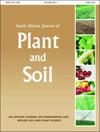Rooting potential of the ‘vleitee’ honeybush ( Cyclopia subternata ) as affected by growth season and the manipulation of stock plant characteristics
IF 0.7
Q3 AGRONOMY
引用次数: 0
Abstract
AbstractTo ensure a high-quality, sustainable supply of South African indigenous honeybush (Cyclopia spp.) tea to domestic and international markets, a shift from wild harvesting practices to true-to-type clonal material is required. This study investigated the impact of stock plant rejuvenation period and seasonality, and the harvesting position of cutting material on stock plants, on the rooting success of four genotypes of Cyclopia subternata Vogel, the most widely cultivated honeybush species. Cutting rooting success varied between 65–94% in summer and 49–91% in autumn, whilst winter-rooted cuttings showed poor rooting success (0–7%). Cutting dry weight was positively correlated with rooting percentage (r = 0.647; p ≤ 0.001). The rooting success of cuttings was strongly impacted by internal stock plant factors, such as clonal effects, cutting position and rejuvenation period. The use of terminal, semi-hardwood cuttings collected in autumn, following 15 months of regrowth, is recommended to achieve acceptable-to-high rooting success. This study confirms that the clonal propagation of C. subternata via cuttings could be a viable option for the sustainable production of high-quality honeybush tea, provided the selection criteria of the stock plant material used as the cutting source is carefully considered.Keywords: cuttingclonesselectionphenologyrejuvenation AcknowledgementsThe authors are grateful for the funding provided by the Western Cape Department of Agriculture. Thank you to Dr Cecelia Bester from the Agricultural Research Council for the C. subternata plant material used in this research.生长季节和砧木性状对蜜丛生根势的影响
摘要为了确保高质量、可持续地向国内和国际市场供应南非本土蜜树(Cyclopia spp.)茶叶,需要从野生采收实践转向真正的克隆材料。本研究研究了砧木再生周期、季节以及砧木扦插材料的采收位置对四种基因型蜜丛(Cyclopia subternata Vogel)生根成功率的影响。夏季扦插生根成功率为65 ~ 94%,秋季为49 ~ 91%,冬季扦插生根成功率为0 ~ 7%。扦插干重与生根率呈正相关(r = 0.647;P≤0.001)。扦插生根的成功与否受砧木植株内部克隆效应、扦插位置和年轻化期等因素的强烈影响。建议使用秋季收集的顶生半硬木插枝,经过15个月的再生,以获得可接受的到高的生根成功。本研究证实,只要仔细考虑作为扦插源的砧木材料的选择标准,通过扦插繁殖蜜丛茶是可持续生产优质蜜丛茶的可行选择。关键词:扦插、克隆、选择、物候、再生感谢作者感谢西开普省农业部的资助。感谢农业研究委员会的Cecelia Bester博士在本研究中使用的C. subternata植物材料。
本文章由计算机程序翻译,如有差异,请以英文原文为准。
求助全文
约1分钟内获得全文
求助全文
来源期刊

South African Journal of Plant and Soil
Agricultural and Biological Sciences-Plant Science
CiteScore
1.90
自引率
11.10%
发文量
32
期刊介绍:
The Journal has a proud history of publishing quality papers in the fields of applied plant and soil sciences and has, since its inception, recorded a vast body of scientific information with particular reference to South Africa.
 求助内容:
求助内容: 应助结果提醒方式:
应助结果提醒方式:


